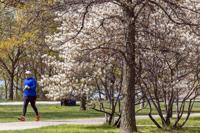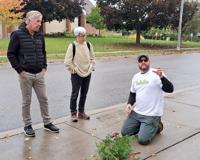Northern lights activity has increased in Ontario and across Canada â which is no surprise as solar activity is peaking.
We have been graced with incredible displays â some seen last year in and .
This year, displays were seen â with more possibly in store. All of this is unsurprising for those who pay attention to the sun’s activity.
What is a solar maximum â and what does it mean for viewing the northern lights?
Right now, the sun is in a period of high activity known as a solar maximum, which is expected to reach its peak this July. The sun gets more active as its magnetic field flips.
In October 2024, in its 11-year solar cycle, a period that could last a year. An X9.0-level solar flare caused northern lights to be visible as far south as Florida that same month.
During a solar maximum, the sun is more stormy and unsettled, resulting in more solar flares and coronal mass ejections that can hurtle particles at Earth.
When the particles interact with the Earth’s atmosphere and magnetic field, you get greater chances to see bright northern lights.Â
What causes the northern lights?
Solar activity makes the northern lights come alive.Â
The northern lights are caused by solar particles sent toward Earth by an explosion of energy on the sun’s surface. It’s when the ejected material interacts with Earth’s atmosphere that the beautiful colours dance in the sky.Â
âWhen a solar storm comes towards us, some of the energy and small particles can travel down the magnetic field lines at the north and south poles into Earth’s atmosphere,â . âThere, the particles interact with gases in our atmosphere resulting in beautiful displays of light in the sky. Oxygen gives off green and red light.â
The immense explosions of light, energy and solar radiation coming from the sun create conditions known as space weather. As particles coming from the sun interact with the Earth’s atmosphere, there are more chances to view the northern lights â even at lower latitudes.Â
When are the best times to see the northern lights in Canada?
Typically, between September to late March is considered a good time to view the northern lights with longer nights in Canada.
Destination Ontario said the is when the sky is darkest an hour or two after sunset toward midnight and clear of cloud coverage or light pollution.
Avoiding a full moon is ideal, as its brightness can reduce your ability to see the northern lights.
While the northern lights can be reported every season, late fall, winter and early spring are considered more favourable for viewing as the cold air contains less moisture than warm summer nights.
Why are the northern lights more common around the spring equinox?
Auroras are stronger around the spring and fall equinoxes due to the Earth and sun being more optimally aligned.Â
During the equinoxes, the equator is aligned with the sun. The was March 20.
âThe effect known as Russell-McPherron is down to the alignment of the sun and Earth around the spring and autumn equinox and means that you are twice as likely to see the aurora in spring and autumn than winter and summer,â according to an .
Will we see more northern lights in 2025?
Walter Stoddard, a researcher-programmer at the Ontario Science Centre, explained in October that we are heading up the hill of a solar maximum, which is expected to peak in July.
âThe ejections are more frequent, but they’re also larger,â he said of the sun’s activity during its solar maximum phase. âIt’s more energy â it’s more energized.â
These ingredients make for more bright and frequent northern lights displays, as was the case in 2024 and again this year.
Stoddard said as we move through the solar maximum period we can expect to see more amazing northern lights displays in 2025 into 2026 and potentially 2027 as the solar activity starts to calm again.
How do I check the Aurora forecast?
You can check the forecast by checking out the .
Error! Sorry, there was an error processing your request.
There was a problem with the recaptcha. Please try again.
You may unsubscribe at any time. By signing up, you agree to our and . This site is protected by reCAPTCHA and the Google and apply.
Want more of the latest from us? Sign up for more at our newsletter page.




























To join the conversation set a first and last name in your user profile.
Sign in or register for free to join the Conversation